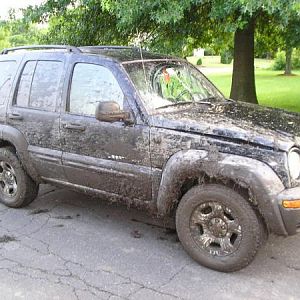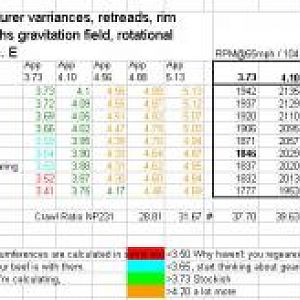This posting applies to the 42RLE transmission as installed to my 2006 Liberty V6. The heavier-duty 545RFE transmission in the diesel and in some other (?) Liberties is probably different. The cost of the job for the do it yourself mechanic is about $100. This is a pretty straightforward transmission fluid change.
There is another HowTo posting about automatic transmission fluid change, but I believe that one applies to the heavier transmission. I'm not very experienced with Jeeps other than my own, so I'm not sure about all of the applicability details.
To prepare for this job, I'd recommend that you buy 8 quarts of Mopar ATF+4. There are other manufacturers selling ATF+4, but I prefer the factory stuff. This is pretty expensive. I was surprised to find that my local Jeep dealer charged me $9.28 a quart, while the local Chrysler dealer had it at a retail list price of 7.42, and they sold it to me for less with a professional discount.
You'll also need a filter and a pan gasket. I bought the filter at the dealership (though I probably could have bought an equally good one for less at the NAPA store). I bought the gasket at the NAPA store -- you can't buy this at the dealership because the factory installation of the pan is done with RTV sealant, and without a gasket.
You'll also need some thread sealant (I used blue Loctite) for one of the bolts.
You'll need tools to remove and replace the Torx #25 screws for the filter, and the pan bolts which have 10mm heads.
You should not attempt this when the transmission is hot.
To get started, remove the bolts for the transmission pan. Leave two bolts along the back of the pan finger tight, then tap or lightly pry on the pan. When it comes loose, a lot of fluid will drain out of it, so be prepared to catch it. Push the pan back up and remove the last two bolts with your fingers, and lower the pan.
Remove the two Torx #25 screws and pull the filter down from the valve body. There is an o-ring at the filter connection -- remove the o-ring if it was left in place in the valve body. Then install the new filter, using a new o-ring, lubricated in ATF.
Now you have to clean all of that RTV from the pan. You need to take your time and do a good job with this. In every shop I've ever been in, the standard procedure is never to use RTV sealer on an automatic transmission pan, because you don't want any little gobs of that stuff to get up inside the valve body. I have to assume that they use it in the factory to reduce costs, but it's a hassle when you want to change the fluid! Clean the magnet in the bottom of the pan, and make sure that all of the RTV is gone. Wash the pan in solvent and blow it off -- or if you don't have compressed air, use Brake Clean and wipe it clean.
Reinstall the pan, using the gasket (don't use RTV). I used a very small amount of high-tack sealant to stick the gasket to the pan for reassembly (my gasket did not have undersized holes to keep it together). Don't use any sealant between the gasket and the transmission.
The manual I used (AllData) said that one of the bolts needs to be sealed -- it's the second from the front, on the left side. I believe the bolt head should be painted, to indicate which one. I used blue Loctite to seal the threads, though I couldn't really see why this was required.
The manual said to refill with 4 quarts, and then start the engine and fill it the rest of the way while idling. (Of course you fill it through the dipstick tube -- if you don't have a funnel for this get one from any auto parts store. Also slowly move the shift lever between P/R/D.) I had measured what I drained out (at least most of it), and it was just about 6 quarts, so I put in about 5 1/2 quarts before starting the engine. I ended up putting in 7 quarts in all -- now the dipstick reads just under the HOT high mark, after driving the car. As with many cars, the dipstick is hard to read after you've been filling it. Wait while it idles for a few minutes and you'll be able to read it.
The hardest part of this job was cleaning the RTV off of the pan. The most mysterious part was the price difference for the fluid, between the Jeep dealer and the Chrysler dealer.
Another item of interest is that my local Jeep dealer told me that they don't do this job. Instead they do a flush, and they put in an additive with the flush. This is curious, because Technical Service Buletin 26-003-07 (Fluid Flushing Recommendations) says not to flush, and never to use an additive. I have to assume that they do the flush because they make really good money on it. They run 16 quarts of ($10.00) fluid through the system. Also, they don't have to do all of the time-consuming cleaning of the RTV on the pan. They gave me a quote of $280 for the job. I think it's probably better to do a regualr fluid and filter change, as the factory recommends. It's also cheaper.
I hope this is helpful.
John In Virginia
There is another HowTo posting about automatic transmission fluid change, but I believe that one applies to the heavier transmission. I'm not very experienced with Jeeps other than my own, so I'm not sure about all of the applicability details.
To prepare for this job, I'd recommend that you buy 8 quarts of Mopar ATF+4. There are other manufacturers selling ATF+4, but I prefer the factory stuff. This is pretty expensive. I was surprised to find that my local Jeep dealer charged me $9.28 a quart, while the local Chrysler dealer had it at a retail list price of 7.42, and they sold it to me for less with a professional discount.
You'll also need a filter and a pan gasket. I bought the filter at the dealership (though I probably could have bought an equally good one for less at the NAPA store). I bought the gasket at the NAPA store -- you can't buy this at the dealership because the factory installation of the pan is done with RTV sealant, and without a gasket.
You'll also need some thread sealant (I used blue Loctite) for one of the bolts.
You'll need tools to remove and replace the Torx #25 screws for the filter, and the pan bolts which have 10mm heads.
You should not attempt this when the transmission is hot.
To get started, remove the bolts for the transmission pan. Leave two bolts along the back of the pan finger tight, then tap or lightly pry on the pan. When it comes loose, a lot of fluid will drain out of it, so be prepared to catch it. Push the pan back up and remove the last two bolts with your fingers, and lower the pan.
Remove the two Torx #25 screws and pull the filter down from the valve body. There is an o-ring at the filter connection -- remove the o-ring if it was left in place in the valve body. Then install the new filter, using a new o-ring, lubricated in ATF.
Now you have to clean all of that RTV from the pan. You need to take your time and do a good job with this. In every shop I've ever been in, the standard procedure is never to use RTV sealer on an automatic transmission pan, because you don't want any little gobs of that stuff to get up inside the valve body. I have to assume that they use it in the factory to reduce costs, but it's a hassle when you want to change the fluid! Clean the magnet in the bottom of the pan, and make sure that all of the RTV is gone. Wash the pan in solvent and blow it off -- or if you don't have compressed air, use Brake Clean and wipe it clean.
Reinstall the pan, using the gasket (don't use RTV). I used a very small amount of high-tack sealant to stick the gasket to the pan for reassembly (my gasket did not have undersized holes to keep it together). Don't use any sealant between the gasket and the transmission.
The manual I used (AllData) said that one of the bolts needs to be sealed -- it's the second from the front, on the left side. I believe the bolt head should be painted, to indicate which one. I used blue Loctite to seal the threads, though I couldn't really see why this was required.
The manual said to refill with 4 quarts, and then start the engine and fill it the rest of the way while idling. (Of course you fill it through the dipstick tube -- if you don't have a funnel for this get one from any auto parts store. Also slowly move the shift lever between P/R/D.) I had measured what I drained out (at least most of it), and it was just about 6 quarts, so I put in about 5 1/2 quarts before starting the engine. I ended up putting in 7 quarts in all -- now the dipstick reads just under the HOT high mark, after driving the car. As with many cars, the dipstick is hard to read after you've been filling it. Wait while it idles for a few minutes and you'll be able to read it.
The hardest part of this job was cleaning the RTV off of the pan. The most mysterious part was the price difference for the fluid, between the Jeep dealer and the Chrysler dealer.
Another item of interest is that my local Jeep dealer told me that they don't do this job. Instead they do a flush, and they put in an additive with the flush. This is curious, because Technical Service Buletin 26-003-07 (Fluid Flushing Recommendations) says not to flush, and never to use an additive. I have to assume that they do the flush because they make really good money on it. They run 16 quarts of ($10.00) fluid through the system. Also, they don't have to do all of the time-consuming cleaning of the RTV on the pan. They gave me a quote of $280 for the job. I think it's probably better to do a regualr fluid and filter change, as the factory recommends. It's also cheaper.
I hope this is helpful.
John In Virginia










